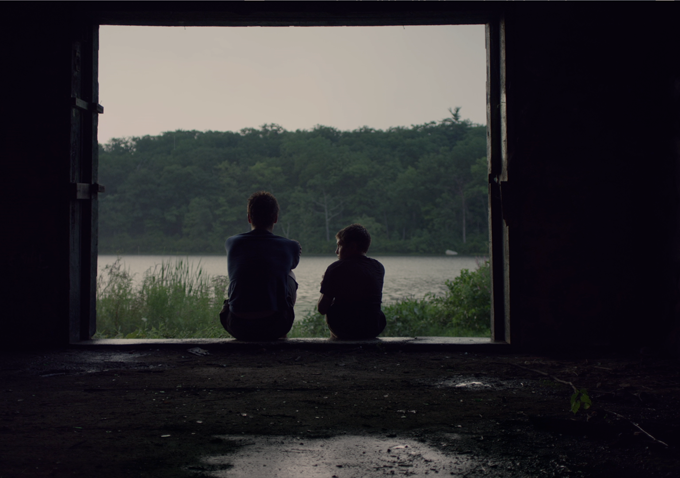
In a strangely beautiful and unnerving moment, “Hide Your Smiling Faces” opens up with an arresting visual: a close-up of a snake—its mouth wrapped around a fish, slowly struggling to swallow it whole. It’s disturbing, fascinating and the shot lingers with a sense of awe, curiosity and wonder. And it many ways, this remarkably captured moment sums up everything this striking debut feature is about.

In a summer seemingly like any other of early adolescence, two brothers, Eric (Nathan Varnson) and Tommy (Ryan Jones), their dog and their friend Ian (Ivan Tomic) explore the fringes of their rural American surroundings. They ride bikes, swim in dirty lakes, wrestle with each other to let off steam, shoot BB guns at wildlife, investigate the nooks and crannies of the local woods and mess about like kids are wont to do. However, the bucolic feeling of the milieu is disturbed early on and soon a tense pall looms portentously over the setting and never quite disappears. Ian shows the brothers his dad’s gun and when the father (Colm O’Leary)—a loner, and possibly alcoholic—finds out, he abusively chews them out, also threatening to shoot the dog if and when it comes on to his property again.
Summer is already confusing and difficult for the brothers—the family has moved to a remote part of the Delaware/New Jersey periphery far away from what we’re left to assume was a sense of place, comfort and belonging. And yet it becomes even more unbearable when the boys stumble upon Ian’s body, his death a result of mysterious causes; though some assume he simply fell while playing on a nearby bridge.

And while the ominous specter of Ian’s potentially psycho father and this loaded gun lay over the film like an uncomfortable admonition, this is about as interested in “plot” as the movie is. While the narrative tracks the boys’ quiet pain and their inability to process this devastating tragedy, ‘Smiling Faces’ is much more interested in exploring feelings and a frame of mind. Both in the curiosity of exploration early on and the heartbreaking frustration and anger that comes when one is too young and inexperienced to properly express and articulate emotion.
Slightly opaque on the surface, what’s actually the case is that this mature, startling-composed drama just never deigns to spell things out, giving time for your imagination to fill in the breathing room, spaces of which this movie has plenty. It’s never obvious. We’re never quite sure where the boys moved from, or just how unhinged Ian’s father is. When one of Eric’s friends contemplates suicide and Eric is once more torn up inside about his inability to process – which manifests in outbursts of anger – we’re not sure what exactly is troubling this boy outside of a powerful sense of disconnection and loneliness. The devil is not in the details, he’s in the mood, and that creates an unsettling sense of disquiet in a movie that’s far more concerned with showing you things than telling you how to feel.
Minimalist, mostly silent with spare amounts of dialogue, ‘Smiling Faces’ is meditative, haunting and yet still very beautiful. While it’s essentially nothing like a Terrence Malick movie (“Malick-esque” being the most abused term of 2013), what it does share spiritually with that mystical filmmaker is a sense of curiosity and wonder with a similar patience to explore the silences and mysteries of nature. But this is where the similarities should end. Fitted with an air of anxiety over it that something tragic is going to happen, “Hide Your Smiling Faces” is a different beast; it’s almost as if Michael Haneke had directed David Gordon Green’s seminal inaugural work, “George Washington,” which also had preoccupations with the secret lives of children. Those quiet lives that parents are usually too busy to pay attention to when children play with bugs, make faces for no one to see and dig around in their own curiosity.

Discovery is always a big part of the film media narrative. Those rushing to declare so and so the next you know what, the next heir apparent, the next second coming. Being there first to plant the flag into the ground and claim your stake on an individual, a moment, a scene, etc. So it’s with some trepidation and reservation—hyperbole never having served anyone well—that I say that writer/first-time feature-length filmmaker Daniel Patrick Carbone is a true discovery and a revelation—a bright, thoughtful filmmaker who’s now one to immediately pay attention to and watch.

The influence of other, similarly contemplative and mood oriented peers is also apparent. Carbone borrows Irish actor Colm O’Leary from Rick Alverson’s “The Builder” and “New Jerusalem” plus the composer from the latter film as well (plus a Director of Photography, the connection is pronounced; Carbone shot Alverson’s upcoming film “Rabbit”)
And speaking of, the music, written by Robert Donne (Labradford, Spokane) is just stunning; a disquieting soundscape of atmospheric swells that accentuate the movie’s dual sense of dread and beauty, life and death. Let it be said these aren’t aimless drones either —something of a trend in “soundscapey” scores of late—but another unsettling texture to the picture.
Delicately shot with a sense of intimacy, but never precious, “Hide Your Smiling Faces” invites you to be as inquisitive about the world as these boys are and to maybe even experience it through their eyes. Featuring two exceptional lead performances from these two boys, first rate beauty-in-ugliness photography and an unusually extraordinary command of tone, Carbone’s picture skillfully articulates the inexpressible; the weird, beautiful struggle that is life. “Hide Your Smiling Faces” is an engrossing debut film, and one that hopefully gets its due. [A]
This is a reprint of our review from the 2013 Tribeca Film Festival.

